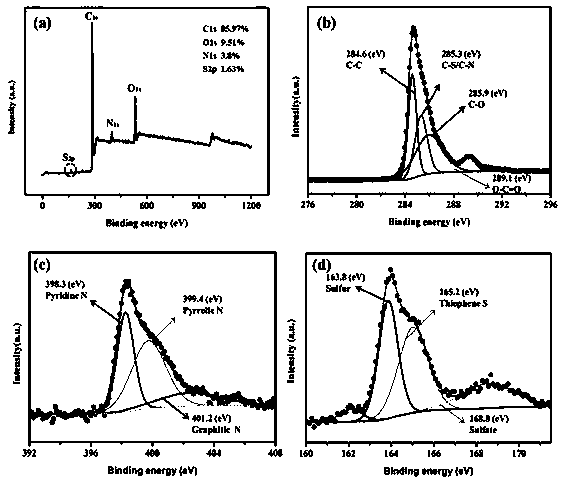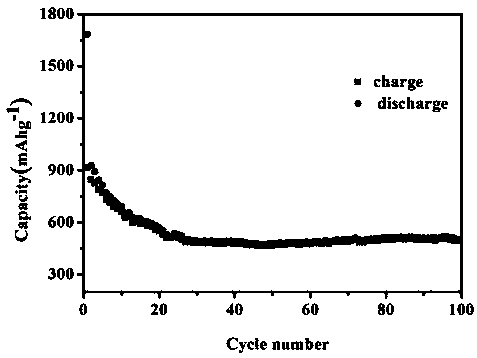Preparation method of nitrogen-sulfur co-doped three-dimensional graphene, prepared product and product application thereof
A nitrogen-sulfur co-doping, graphene technology, applied in nanotechnology for materials and surface science, electrical components, electrochemical generators, etc., can solve the problems of harsh experimental conditions, difficult to achieve large-scale preparation, and high cost , to achieve the effect of simple operation, low cost and large specific surface area
- Summary
- Abstract
- Description
- Claims
- Application Information
AI Technical Summary
Problems solved by technology
Method used
Image
Examples
Embodiment 1
[0022] (1) Preparation of precursor by hydrothermal reaction: First, 100 mg of graphene oxide was dispersed in 10 ml of deionized water to obtain a graphene oxide dispersion, then 0.03 g of melamine was added, stirred at 80°C until completely dissolved, and A liquid was obtained; another 0.04 1 g of thiocyanuric acid was dissolved in 25ml of ethanol to obtain liquid B; slowly add liquid B to liquid A, stir at 70°C for 10 minutes and then put it into a hydrothermal kettle with a filling ratio of 35% and a hydrothermal reaction temperature of 120°C / 4h. After the hydrothermal reaction is completed, freeze-dry to obtain the precursor.
[0023] (2) Preparation of three-dimensional doped graphene by heat treatment: the precursor was placed in a tube furnace, protected by argon, and heated to 600°C at a heating rate of 2°C / min for 5 hours.
Embodiment 2
[0025] (1) Preparation of precursor by hydrothermal reaction: First, disperse 100 mg of graphene oxide in 25 ml of deionized water to obtain a graphene oxide dispersion, then add 0.13 g of melamine, stir at 80°C until completely dissolved, and obtain liquid A; another 0.18 1 g of thiocyanuric acid was dissolved in 25ml of ethanol to obtain liquid B; slowly add liquid B to liquid A, stir at 80°C for 60 minutes, then put it into a hydrothermal kettle, the filling ratio is 50%, and the hydrothermal reaction is 200°C / 12h. After the hydrothermal reaction is completed, freeze-dry to obtain the precursor.
[0026] (2) Preparation of three-dimensional doped graphene by heat treatment: the precursor was placed in a tube furnace, protected by argon, and heated to 700 °C at a heating rate of 5 °C / min for 2 h.
[0027] refer to figure 1 , figure 1 SEM photographs of samples prepared for this example. Using the S-4800 scanning electron microscope (SEM) of Japan Electronics Co., Ltd. t...
Embodiment 3
[0031] (1) Preparation of precursor by hydrothermal reaction: First, disperse 100 mg of graphene oxide in 20 ml of deionized water to obtain a graphene oxide dispersion, then add 0.252 g of melamine, stir at 120 °C until completely dissolved, and obtain liquid A; another 0.354 Dissolve thiocyanic acid in 25ml of ethanol to obtain liquid B; slowly add liquid B to liquid A, stir at 120°C for 10 minutes, then put it into a hydrothermal kettle, the filling ratio is 55%, and the hydrothermal reaction is 150°C / 36h . After the hydrothermal reaction is completed, freeze-dry to obtain the precursor.
[0032] (2) Preparation of three-dimensional doped graphene by heat treatment: the precursor was placed in a tube furnace, protected by argon, and heated to 1000 °C at a heating rate of 10 °C / min for 1 h.
PUM
| Property | Measurement | Unit |
|---|---|---|
| Concentration | aaaaa | aaaaa |
Abstract
Description
Claims
Application Information
 Login to View More
Login to View More - R&D
- Intellectual Property
- Life Sciences
- Materials
- Tech Scout
- Unparalleled Data Quality
- Higher Quality Content
- 60% Fewer Hallucinations
Browse by: Latest US Patents, China's latest patents, Technical Efficacy Thesaurus, Application Domain, Technology Topic, Popular Technical Reports.
© 2025 PatSnap. All rights reserved.Legal|Privacy policy|Modern Slavery Act Transparency Statement|Sitemap|About US| Contact US: help@patsnap.com



